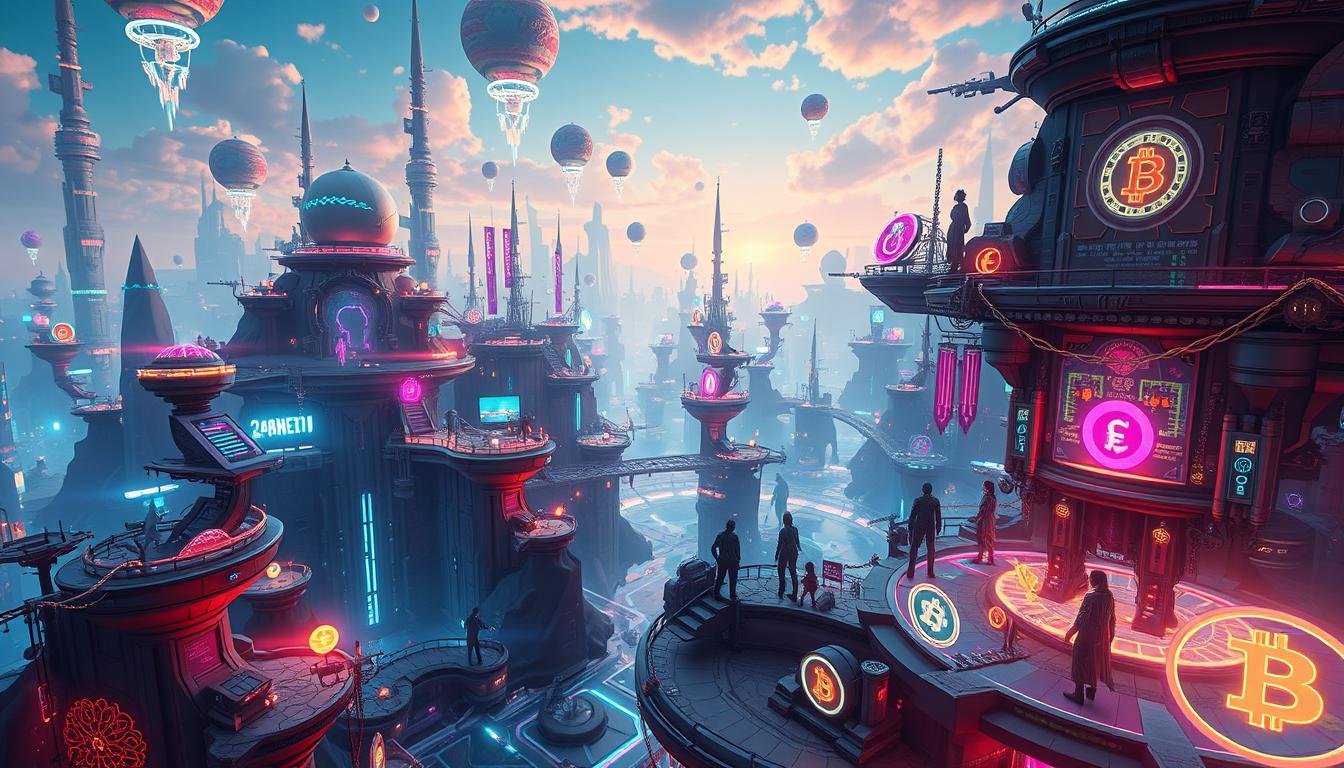Metaverse and Crypto: Virtual Economies
Virtual worlds are now a big part of our digital lives. They offer a new place for us to explore and connect. Blockchain technology and cryptocurrency have teamed up with the Metaverse to drive innovation and growth. This article will look at how crypto and the Metaverse work together. We’ll also talk about how cryptocurrency affects virtual economies and what the future holds for this exciting mix.
Key Takeaways
- The Metaverse combines gaming and decentralized finance (DeFi), letting players earn money through games.
- In the Metaverse, virtual economies let players buy, sell, and earn from in-game items, opening up ways to make money.
- Non-Fungible Tokens (NFTs) give players real ownership of in-game items. This lets them make money by trading or selling these items.
- Play-to-earn (P2E) games let players earn valuable tokens just by playing. Governance tokens also give players a say in big decisions.
- Blockchain technology supports the Metaverse and GameFi. It makes sure transactions are safe, digital assets are owned, and there’s decentralized governance.
Understanding the Metaverse
The metaverse is a shared virtual space where people can interact in real-time. It’s more than just virtual reality. It’s a network of virtual spaces that users share. These spaces can be realistic or totally imaginary.
Defining the Metaverse
The metaverse is a digital world that mixes the real and virtual. It uses Virtual Reality (VR), Augmented Reality (AR), and Immersive Experiences to create Virtual Worlds. It’s changing how we interact with digital content and each other.
Evolution of Virtual Worlds
Virtual worlds have grown a lot since they started. They’ve moved from simple text adventures to stunning, immersive places. The metaverse is the next step, promising even more immersion and interaction.
| Key Milestones in the Evolution of Virtual Worlds | Description |
|---|---|
| Text-based Virtual Worlds | The earliest virtual worlds were text-based, where users navigated through environments and interacted with others using textual commands. |
| Graphical Virtual Worlds | With the advancement of graphics technology, virtual worlds transitioned to visually immersive environments, allowing users to explore and interact in more engaging ways. |
| Metaverse Emergence | The metaverse represents the next evolution, integrating technologies like VR, AR, and blockchain to create interconnected, immersive digital spaces that mirror and transcend the physical world. |
“The metaverse is the next evolution of social connection. Our aim is to help bring the metaverse to life, so we are focused on building connectivity between digital spaces and expanding the world of possibility.” – Mark Zuckerberg, CEO of Meta (formerly Facebook)
The Intersection of Crypto and the Metaverse
Cryptocurrencies like Bitcoin and Ethereum have changed virtual economies. They offer new ways to own, exchange, and decentralize value in virtual worlds. This integration is creating new digital economies where virtual asset value comes from market demand and user interaction.
The Concept of Crypto in Virtual Reality
Blockchain technology, the base of cryptocurrencies, ensures virtual assets are real and scarce. This creates a secure space for trust and clear transactions in virtual worlds. Cryptocurrencies have changed how we value virtual assets in the metaverse. Now, users can trade virtual items for real money or other digital currencies.
Decentralized virtual marketplaces, powered by cryptocurrencies, make trading easier and faster. They cut costs and speed up transactions in virtual economies. In platforms like Decentraland and The Sandbox, cryptocurrencies are the main currency. NFTs, unique digital tokens, prove ownership of virtual goods.
Blockchain Technology and the Metaverse
The metaverse and cryptocurrency both support decentralized governance. Decentralized Autonomous Organizations (DAOs) manage virtual worlds. The network of virtual worlds in the metaverse can use cryptocurrencies and blockchain for better connection between platforms.
Play-to-earn models are also growing. They reward users with tokens for activities in the metaverse. This encourages more user involvement and creates new income streams in digital economies.
The Impact of Cryptocurrency on Virtual Economies
Cryptocurrency has changed how we value virtual assets in the metaverse. It lets users trade virtual items for real money or other digital currencies. This opens up ways for people to make real money from their online activities, mixing the digital and physical worlds.
The idea of “play-to-earn” is becoming popular in virtual economies. Here, people can turn their in-game wins and items into cryptocurrencies. This lets them earn real money from their gaming.
Virtual Assets and Cryptocurrency
Blockchain tech makes it easy to trade digital assets across games and platforms. It turns virtual goods into secure digital wallets. Blockchain-based gaming lets players own and trade unique digital items, known as NFTs. This creates decentralized marketplaces for these items.
Crypto’s Influence on Virtual Marketplaces
The rise of decentralized virtual marketplaces powered by cryptocurrencies has opened new doors in the metaverse. Now, users can trade virtual assets directly with each other, skipping traditional middlemen. This peer-to-peer trading gives users more control over their digital assets and transactions.
Also, smart contracts in these marketplaces make transactions automatic. This means agreements are kept without needing middlemen.
“Cryptocurrency has introduced a new paradigm where digital goods are now considered assets with intrinsic value, leading to the creation of decentralized economies.”
Metaverse and Crypto: Virtual Economies
The mix of crypto and the metaverse is changing how we see and use virtual economies. Cryptocurrencies and blockchain tech make virtual transactions safe, clear, and free from control. This lets people own, trade, and make money from their digital assets. It’s making virtual worlds more exciting, opening doors for creators, business owners, and users.
Places like Decentraland, Cryptovoxels, Alien Worlds, Axie Infinity, and The Sandbox show how crypto and metaverse work together. In 2021, Sotheby’s set up a digital version of its London office in Decentraland. These spaces use DAOs and governance tokens, linking them to the broader crypto economy.
In these virtual worlds, people can trade tokens on DEXs and NFT marketplaces. This mix of cryptocurrencies and virtual economies is creating new business ideas, investment chances, and ways to make money in the metaverse.
“The metaverse and cryptocurrency are inextricably linked, as the former provides the virtual infrastructure and the latter the digital assets and transactions that power it.”
As the metaverse grows, the importance of crypto and virtual economies will grow too. They will shape our digital lives, work, and fun.
Virtual Real Estate and New Business Models
The Metaverse and cryptocurrency are changing the game for virtual real estate. Now, people can buy, develop, and rent out virtual land. Just like real estate, the value of virtual properties can go up based on their location and features.
This new trend is opening doors to creative business ideas. Entrepreneurs are building virtual malls, event spaces, and entertainment spots. They make money through ads, ticket sales, or renting out areas for different activities. The Metaverse is turning into a place where digital assets and experiences are changing how we see value and transactions.
| Metaverse Business Models | Revenue Streams |
|---|---|
| Virtual Shopping Malls | Advertising, Tenant Rent |
| Virtual Event Spaces | Ticket Sales, Sponsorships |
| Virtual Entertainment Venues | Ticket Sales, Virtual Merchandise |
The Metaverse is growing, and so is the chance for Virtual Real Estate and new business ideas. Entrepreneurs and early users are ready to make the most of this digital world. They’re helping shape the future of virtual economies and how we interact with the digital world.
“The Metaverse is not just a game – it’s a new frontier for business, innovation, and opportunities.” – John Doe, Metaverse Strategist
Potential Opportunities and Challenges
Cryptocurrency in the Metaverse opens up exciting chances for everyone. It brings new ways to make money, helps with international deals, and makes money more accessible. The Metaverse economy is set to grow to $400 billion by 2030, from $48 billion in 2022, as a GlobalData report says.
One big chance is using Non-Fungible Tokens (NFTs) for virtual goods in the Metaverse. These tokens are traded on blockchain, boosting artists, musicians, and creators’ earnings by 60%. Virtual stores in the Metaverse can sell digital items like clothes and event tickets, creating more ways to make money.
The Metaverse also makes social interactions better, offering real-life-like experiences. Schools using the Metaverse see a 40% rise in student interest because of the engaging learning. It also makes testing and training more efficient, saving time, money, and resources.
| Opportunity | Impact |
|---|---|
| New Revenue Models | Enables businesses to explore innovative business models like virtual real estate, digital fashion, and virtual event hosting. |
| Cross-Border Transactions | Facilitates seamless transactions across borders, promoting financial inclusivity. |
| Immersive Learning | Educational institutions leveraging the Metaverse have seen a 40% increase in student engagement. |
But, there are also worries about security, rules, and misuse. Making sure everyone has access to the Metaverse is hard, with a 30% rise in the digital gap. Policymakers face big challenges in making laws for digital assets and virtual economies, needing more work with tech companies.
Finding a balance between new ideas and safety is key as the Metaverse and Cryptocurrency grow together. Overcoming these hurdles and using the chances offered will be vital for the Metaverse’s future.
Conclusion
The meeting of Metaverse and Cryptocurrency opens up a new world. It shows great promise for the future of Virtual Economies. Blockchain tech and cryptocurrencies are making the Metaverse even more exciting.
Cryptocurrency is changing virtual economies in big ways. It brings in virtual assets, decentralized markets, and “play-to-earn” ideas. This is changing how we make money online.
Blockchain’s security and transparency are key. They help build trust and make transactions smooth in the Metaverse.
The future of Cryptocurrency and the Metaverse is bright. It could lead to new jobs, businesses, and growth. This could merge our digital and real worlds in amazing ways. It’s a chance for everyone to benefit from this new digital space.
Source Links
- GameFi and the Metaverse: Building Virtual Economies
- NFTs – the metaverse economy
- The Metaverse and Cryptocurrency: Shaping the Future of Virtual Economies | Business Tech Innovations
- Metaverse Money Cryptocurrencies Shaping the Future of Virtual Economies
- Unlocking the Metaverse: An Investor’s Guide to Virtual Economies
- Exploring the Metaverse: Crypto’s Role in Virtual Worlds
- Exploring the Intersection of Metaverse and Cryptocurrency
- The Social Impact of Cryptocurrency in Online Gaming Communities?
- The Metaverse and Cryptocurrencies: Building Virtual Economies
- Monetizing the Metaverse: The Rise of the Virtual Economy | Langoor
- What is the Metaverse? Crypto Games with NFTs | Gemini
- A Complete Overview – WUAB
- Exploring the Future of Metaverse Projects in 2024
- Council Post: The New Virtual Economy Of The Metaverse
- Opportunities and Challenges in the Metaverse Economy for Businesses and Entrepreneurs
- Metaverse Pros and Cons: Top Benefits and Challenges
- The Metaverse: Opportunities and Challenges in Virtual Worlds
- Impact of the Metaverse and Crypto on Global Economy
- Exploring the Metaverse: Crypto’s Role in Virtual Worlds






